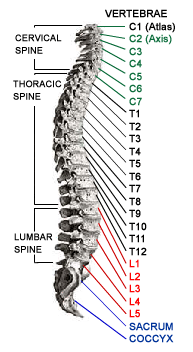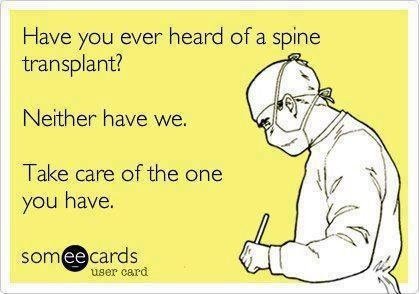Mind Your Spine
The many different styles of dance have varying demands on the body. Having a more complete understanding of how to take care of your body is crucial no matter what types of dance you do. The function and alignment of the spine is at the top of this list.
The spinal column is made up of 24 bones called vertebrae, connecting the skull of the head with the sacrum of the pelvis. In between each vertebra are cartilaginous discs. The discs and vertebrae are held together within a network of ligaments. The shape of the vertebrae primarily determines the types of movement available at each segment of the spine. The three basic shapes give us the cervical, thoracic, and lumbar sections to the spine.
The cervical spine, or neck, is made of seven bones numbered from top to bottom as C1 to C7. Their function is to bear the weight of the skull, which can weigh between 8 and 12 pounds typically! The bones are relatively smaller and can move in many directions to make the head (and our senses) readily available to take in the world around us. It is important to keep the back of the neck long, to avoid crunching delicate tissues. This part of the spine typically has the most rotation and side bending.
The thoracic spine, or mid-back, is made up of twelve bones numbered from top to bottom as T1 to T12. These start at the level of the collarbones, and each pair of ribs stem from the thoracic spine and wrap around to the front of the body to the sternum, or breastbone. The bones of the thoracic spine extend out further in the back, which is why the bumps of the mid-back are more easily seen, or floor burned (we’ve all been there!). This limits some extension, while the ribs limit side-bending at this section of the spine. The thoracic spine transfers the weight from the head as well as the weight of the arms and shoulders into the lumbar spine. Much of the forward bending of the body happens in this section of the spine.
The lumbar spine, or low-back, is made up of five bones numbered from L1 to L5 from top to bottom. These bones are very broad as they have to transfer all of the weight from the upper body onto the pelvis. Broad protrusions on the sides of each of the lumbar vertebrae are sites of muscle attachment and greatly limit rotation and side bending at this section of the spine in particular. Leg extension (like arabesque) and back extension largely happen in this area however.
The thoracic spine and tailbone have a curve that reaches back, and we are born with these curves. The cervical and lumbar spines have curves that reach forward, and these develop as a result of gravity as we learn to pick up our heads and sit and walk as babies and toddlers. The “S” shaped curve from the back of the neck down to the tailbone is there to provide the best weight distribution in relation to the downward pull of gravity. The soft-tissue discs allow for ease of movement and also provide shock absorbency. Nerves pass through openings in the vertebrae that feed the entire body. Good alignment means ensuring these soft tissues do not become pinched or worn down.
The placement of the spine mechanically affects the other skeletal structures of the body. While you are reading this, enhance the curve of your thoracic spine by bringing your head forward. Now try to take a big breath into your ribs or look behind you. Do you feel restricted doing these things? Let that go, and straighten your neck by tucking your chin in as far as you can. Now try to look up or turn to your side. Do you feel how other parts of your body, like your abdomen or shoulders are also moving even though they don’t need to? Moving the spine means the hips, ribs, and head are also moving. This sends a domino affect to the shoulders, arms and legs. So, spinal alignment is key to accessing the correct muscles, core strength, injury prevention, and finding balance during rehabilitation.
Some styles of dance require a low stance, and a more hunched over position. This may cause tension in the low back, chest, shoulders, and neck. Other genres are taught by de-emphasizing the curves of the spine and holding the back “straight.” This can create excessive tension around the spine, limit breath flow, over-tax the hip flexors and tweak the hamstrings. Some spinal misalignments can create a bracing through the core (see my article about the diaphragm). Other curve deviations can be happening due to the placement of the legs (see my article about hyperextension of the knees).
Dance is not an “even” practice.
We absolutely need to provide balance with effective warm-ups, cool-downs, cross-training, and conditioning. Look at the demands of your art form, and introduce stretching or strengthening that off-sets them. Be wary of how you sit, stand, and walk when not in the studio as well (or should I say when you are not dancing even in the studio). Slouchy posture, asymmetrical stances, leaning, stooping over your iPhone, how you drive, etc all contribute to the build-up of patterns that can either help or hinder you as a performing artist.
So of all the things to check out in the mirror, spend some time looking at those curves – of your back, that is!
Happy dancing!





